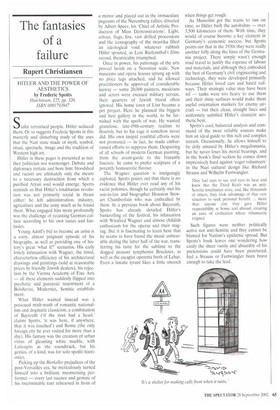The fantasies of a failure
Rupert Christiansen
HITLER AND THE POWER OF AESTHETICS by Frederic Spotts Hutchinson, £25, pp. 320, ISBN 0091793947 Stalin terrorised people, Hitler seduced them. Or so suggests Frederic Spotts in this masterly and disturbing study of the uses that the Nazi state made of myth, symbol, ritual, spectacle, image and the tradition of Western high art.
Hitler in these pages is presented as neither politician nor warmonger. Debate and diplomacy irritate and bore him; bloodshed and racism are ultimately only the means to a necessary destruction from which a purified Aryan soul would emerge. Spotts reminds us that Hitler's totalitarian revolution was not primarily social in thrust either: he left administration, industry, agriculture and the army much as he found them. What engaged him more profoundly was the challenge of recasting German culture according to his own tastes and fantasies.
Young Adoifs bid to become an artist is a sorry, almost poignant episode of his biography, as well as providing one of history's great 'what if?' scenarios. His early lonely infatuation with Wagner. the timid, characterless efficiency of his architectural drawings and paintings (sold at reasonable prices by friendly Jewish dealers), his rejection by the Vienna Academy of Fine Arts — all these elements suddenly flipped into psychotic and paranoid resentment of a Bolshevist, Modernist, Semitic establishment.
What Hitler wanted instead was a poisoned mish-mash of romantic nationalism and dogmatic classicism, a combination of Bayreuth ('if the man had a heart,' claims Spotts. 'it was here, if anywhere, that it was touched') and Rome (the only foreign city he ever visited for more than a day). His fantasy was the creation of urban vistas of gleaming white marble. with Lohengrin as the soundtrack, but his genius, of a kind, was for solo spotlit histrionics.
Picking up the Bierkeller prejudices of the post-Versailles era, he meticulously turned himself into a brilliant, mesmerising performer — every last nuance and gesture of his interminable rant rehearsed in front of
a mirror and played out in the immaculate pageants of the Nuremberg rallies, directed by Albert Speer, his 'Chief of Artistic Production of Mass Demonstrations'. Light, colour, flags, fire, vast drilled processions and the iconography of the swastika filled an ideological void: whatever rubbish Hitler spouted, as L,eni Riefensthal's films record, theatricality triumphed.
Once in power, his patronage of the arts proved lavish on a Neronian scale. New museums and opera houses sprung up with no price tags attached, and he allowed practitioners he approved of considerable leeway — some 20,000 painters, musicians and actors were excused military service, their quarters of Jewish blood often ignored. His home town of Linz became a pet project. Here he planned the biggest and best gallery in the world, to be furnished with the spoils of war. He wanted grandiose, late-19th-century realism to flourish, but to his rage it somehow never did. His own insipid youthful efforts were not promoted — in fact, he made embarrassed efforts to suppress them. Despairing of all schools of modern German painting, from the avant-garde to the blatantly fascistic, he came to prefer sculpture of a potently homoerotic flavour.
The Wagner question is intriguingly explored. Spotts points out that there is no evidence that Hitler ever read any of his racist polemics, though he certainly met his son-in-law and biographer Houston Stewart Chamberlain who was enthralled by them. In a previous book about Bayreuth, Spotts has already detailed Hitler's bankrolling of the festival, his infatuation with Winifred Wagner and almost childish enthusiasm for the operas and their staging. But it is fascinating to learn here that he seems to have found the music unbearable during the latter half of the war, transferring his taste for the sublime to the dogged peasant symphonist Bruckner, as well as the escapist operetta froth of Lehar. Even a lunatic tyrant likes a little smooch when things get rough.
As Mussolini got the trains to run on time, so Hitler built the autobahns — over 3,500 kilometres of them. With time, they would of course become a key element in Germany's economic success, but Spotts points out that in the 1930s they were really another folly along the lines of the Germania project. There simply wasn't enough road travel to justify the expense of labour and materials, and although they embodied the best of Germany's civil engineering and technology, they were developed primarily because Hitler loved cars and hated railways. Their strategic value may have been nil — tanks were too heavy to use them and their shiny surfaces would make them useful orientation markers for enemy aircraft — but their clean, straight lines and uniformity satisfied Hitler's classicist aesthetic bent.
Spotts's cool, balanced analysis and command of the most reliable sources make him an ideal guide to this rich and complex terrain. Occasionally, he allows himself to be drily amused by Hitler's megalomania, but he never loses his moral bearings, and in the book's final section he comes down impressively hard against 'eager volunteers' in the Nazi cultural design like Richard Strauss and Wilhelm Furtwangler.
They had eyes to see and ears to hear and knew that the Third Reich was an antiSemitic totalitarian state, and, like thousands of others, they took advantage of that very situation to seek personal benefit ... more than anyone else they gave Hitler respectability at home and abroad, creating an aura of civilisation where inhumanity reigned.
Such figures were neither politically active nor anti-Semitic and they cannot be blamed for Nazism's epidemic spread. But Spotts's book leaves one wondering how easily the sheer vanity and absurdity of his pretensions could have been punctured, had a Strauss or Furtwangler been brave enough to take the lead.


































































































 Previous page
Previous page